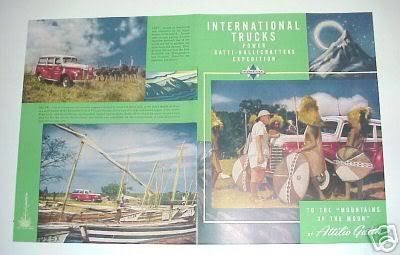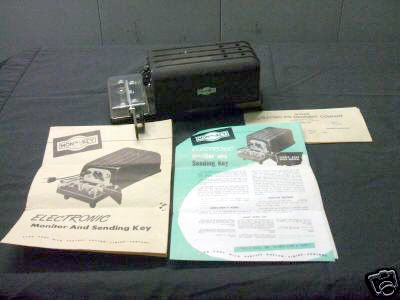After using my daughter's mp3 player on a recent road trip, I decided that Dad had to have one. I didn't need a name brand, nor did I need one with all the bells and whistles. I was after cheap, cheap, cheap, and I found a no-name Chinese import mp3/mp4 player that fits the bill.

I also received my like-new condition magazine published by International Harvester regarding The Gatti-Hallicrafters 1948 expedition to “The Mountains of the Moon” in Africa. It's a fascinating look at the equipment that Commander Gatti took on the expedition, which was co-sponsored by Hallicrafters. Hallicrafters conducted a contest in summer 1947 to select the amateur who would serve as the expedition's operators. The first round of finalists were selected by the ARRL; the list of 12 were sent to Hallicrafters, where Bill Halligan narrowed it down to two young men.
The men traveled to New England to visit Gatti at his estate, but before their interviews, they had decided they would attempt to convince Gatti that the job was too big for just a single operator. They convinced Gatti that it would be better to have two operators, since Hallicrafters' sponsorship contract specified a certain amount of amateur activity while the expedition was in Africa.
Gatti decided to take both men, a good move considering the amount of work was required in setting up the station at each stop.
One of my prize Hallicrafters collectibles is a promotional pasteboard safari-style helmet given away by Hallicrafters dealers to those who purchased receivers or ham gear during the promotion. I did some preliminary work on a chautauqua presentation, as the expedition was a fascinating one that involved ham radio, personalities, and conflict. I don't think there's many chautauquas regarding ham radio, and the thought may sound silly, but after attending a couple of theme I found them to very interesting.
MON-KEY. I haven't taken time to write much about my new Mon-Key electronic keyer I snapped up on eBay recently.

I was the sole bidder on the key, which I thought unusual. There were zero bids on the Mon-Key for the entire week it was listed — which normally is a sign that 8 or 10 collectors are watching it and plan to snipe their bids in the closing seconds.
That didn't happen. My last-second bid was the only one.
The Mon-Key arrived double boxed. The inner box was the key iin the original shipping box, along with all the papers and even the original letter the company sent after the potential buyer had sent an inquiry about the cost of air mail shipping.
The key looks like new. Other than 60 years of dust on the exterior of the box, its almost like a time warp back to 1948.
The buyer was a radioman in the U.S. Navy, and the Mon-Key had to be shipped air mail to his APO address. The shipping cost was $5.20; the key was $49.95. The auction included the manual, the flyer about the Mon-Key; the original invoice and a letter signed by the company owner.
I don't know how much the key was used. Its absolutely in mint condition, as though it was never out of the box for long. I've not tried to power up the key because I don't have a variac, and I'm not about to blow the thing up!
I have the first Mon-Key I bought quite some time ago, and its still a work in progress. It's in good shape, though its a work in progress I need to finish.
The Mon-Key did not use a transformer in its power supply, it runs the tubes in series with a resistive line cord to add up to 120 VAC. The resistive line cord is a bad idea, it simply means the cord gets hot and has to dissipate heat as it drops the line voltage down. Resistive line cords typically meant a cheapskate design to avoid the cost of a transformer.
There's a way to use diodes to drop the voltage down, and that's what I'm going to do with my project Mon-Key. The new one I just got is going to stay as-is for a while until I get better acquainted with the electronics of making the first one work as it should.
SPEED-X REDUX. A few nights ago I took apart the Early Speed-X key (the one with the black base and red plexiglass thumb piece) and spent a good deal of time, elbow grease and 409 getting it cleaned up. Parts of the key had some sort of paint or epoxy on it, brownish black in color. I had to chip that coating off with an exacto knife. The key really looks much better than I would have imagined at first. It's not a mint example, but it has come a long way from what it looked like at first.
The action of the key is good. It feels solid and dependable. The contacts are clean and they make-and-break fine without scratchiness. Most of the chrome parts look fine, the ones that don't are some of the old Vibroplex adjustment screws I pulled out of my junk box. Still looks better than it did, and operates nicely to boot.
The only other eBay news was that I picked up another McElroy Mac Key DeLuxe in a recent auction. The price was right, and couldn't pass it up. When looking a key prices, the Mac Keys usually sell for more than Vibroplex keys, but that's not been the case recently. The Macs are harder to find and more collectible, but I suspect the fact they're less well known limits their appeal to collectors who know what they're looking at.
PRO NEWS. I got the go-ahead from my technician to send the 746PRO in for service. I hope to get it packed up Monday, double boxed and sent priority mail. I'm not going to rush packing it. We'll see.

Excellent read, I just passed this onto a friend who was doing a little research on that. And he actually bought me lunch as I found it for him smile So let me rephrase that: Thanks for lunch! “Life is a continual upgrade.” by J. Mark Wallace.